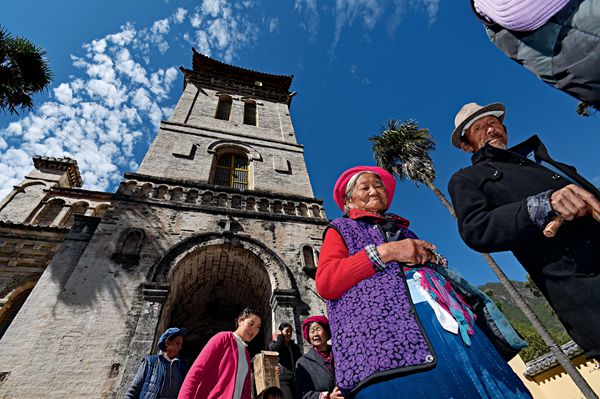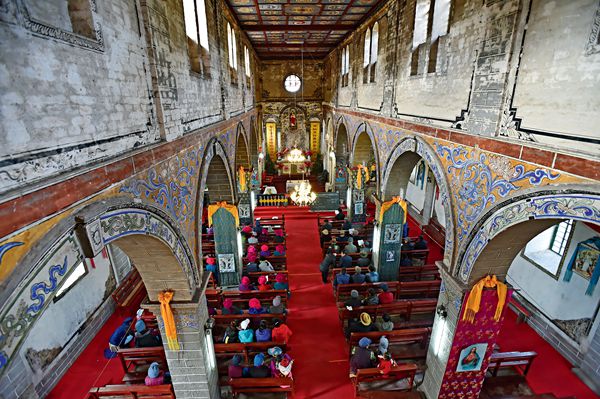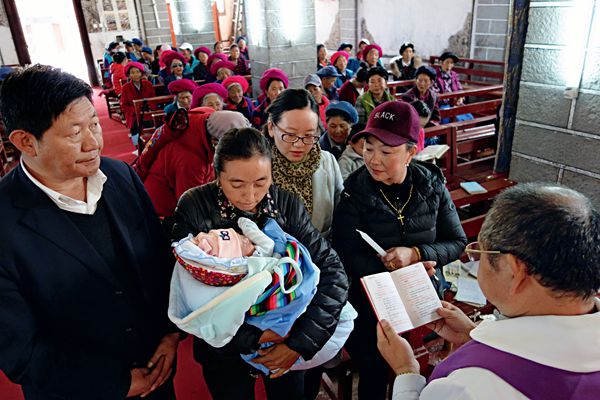Catholic Church in a Tibetan village
- By Lu Rucai
 0 Comment(s)
0 Comment(s) Print
Print E-mail China Today, February 6, 2017
E-mail China Today, February 6, 2017
CizhongI is an administrative village of Diqing Tibetan Autonomous Prefecture in Yunnan Province. Though, with around 200 households of 1,000 residents, it is small, Cizhong is nonetheless well-known among travelers and religious enthusiasts in China.
More than 100 years ago, French missionaries built a Catholic church here. This renders Cizhong both a sacred place for Catholics and a tourist destination. A Catholic church in a Tibetan village? This may seem incongruous, but to local residents it is as natural as their daily salt.
Tibetan Catholics
Minling Mountain, one of the eight mountains of deep religious and cultural significance in Tibetan Buddhism, is situated in Deqen County of Diqing Tibetan Autonomous Prefecture. The mountain, at whose foot the famous Lancang River roars past, is also a gateway to Tibet from Yunnan. These towering precipitous mountains are surrounded by rivers, so the people living here seldom travel beyond them. This is where Cizhong Village is situated.
|
The Cizhong Catholic church congregation consists mainly of elderly Tibetan villagers. |
Cizhong Church, in the French Gothic architectural style, is at the center of the village. Built in 1921, it was at that time a main Catholic church in Yunnan Province.
Of the 1,000 people from the Tibetan, Han, Lisu, and Naxi ethnic groups that live in Cizhong, 60 percent are Catholics. Now 88, village elder Xiao Jieyi is a rich source of historical facts about Catholic activities in Cizhong.
Xiao Jieyi, born in 1929, was given the Christian name Francois. He said that to European Catholics, Tibet has never lost its magnetism as a holy land, and they have long hoped to introduce their religion there. But they got no further than Yunnan, Tibet’s neighboring province.
|
The church is built in a basilica style while Chinese elements are apparent in its interior. |
Xiao Jieyi’s father came to Weixi County in Deqen from Dajianlu (now Kangding) in Sichuan with the French missionary Xu Wuzhong (Jean-Baptiste-Pierre-Victor Ouvrard, 1880-1930), when he was 18 years old. He later married Xiao Jieyi’s mother, a Tibetan girl from the local nunnery. Xiao Jieyi was their fourth child.
According to Xiao Jieyi, his father spoke fluent Latin, and was of immense help to several priests here. However, preaching Catholicism in this Tibetan village was not easy. Prior to Wu Xuzhong, the first pioneering Catholics to arrive in Yunnan dressed as merchants and studied the Tibetan language at local Tibetan Buddhist monasteries. They later introduced Western medicine and schools there. After gaining the trust of the local residents, to bring the voice of God to villagers these priests played gramophone records outside the church of Tibetan monks’ translation of Catholic doctrines. Gradually, Catholicism won some converts in this Tibetan Buddhist village.
Tsering Quzong, who lives next-door to the church, is a descendant of the Tusi (a local headman in the feudal society) family of the Naxi ethnic group. Her traditional Tibetan style house has a 100-year history that matches that of the 100-year-old church with which it stands shoulder to shoulder. According to Tsering Quzong, the land on which the church stands originally belonged to her family, as all land at that time was Tusi property. An area of land adjacent to her yard links her house with the vineyard south of the church.
|
A christening ceremony. |
The vineyard was introduced from France, having been cultivated by two missionaries, one of them Swiss and the other French. After 1949, the central government repatriated foreign missionaries from China. Consequently they left China in 1951. They were the last two foreign priests in Cizhong.
The vineyard, which Tsering Quzong manages, now belongs to Cizhong’s forest management station. "It’s said that the Rose Honey grape has long since disappeared in France," she said. A couple of years ago, a few French grape growers came here to find seeds of this variety. Now almost every household in Cizhong and its neighboring villages grows grapes and makes wine both to enjoy and sell to tourists.
Xiao Jieyi has been learning the Tibetan language at the church since childhood. When he was 13, he was sent to learn Latin, Chinese, and Catholic doctrine as part of his training to be a priest. Later, in 1945, he was sent for further study at Kunming’s Catholic seminary, where he learned French and Latin for three years. Now 88 years old, he still remembers all the priests who came to the church, their hobbies and their ways. He praises Francois Gore as a learned scholar with a PhD who spoke fluent Tibetan and compiled several Tibetan dictionaries and books of scriptures. He also published a book in French about his 20-year life at the Tibetan village. Swiss priest Rovi excelled at the Lisu language, and the books and hymns he wrote and compiled are popular among believers. Another priest, Andrew, was quick tempered, but helped to build a road linking Cizhong with the Baihanluo Church by the Nujiang River. This considerably simplified travel between the two places for local residents.









Go to Forum >>0 Comment(s)